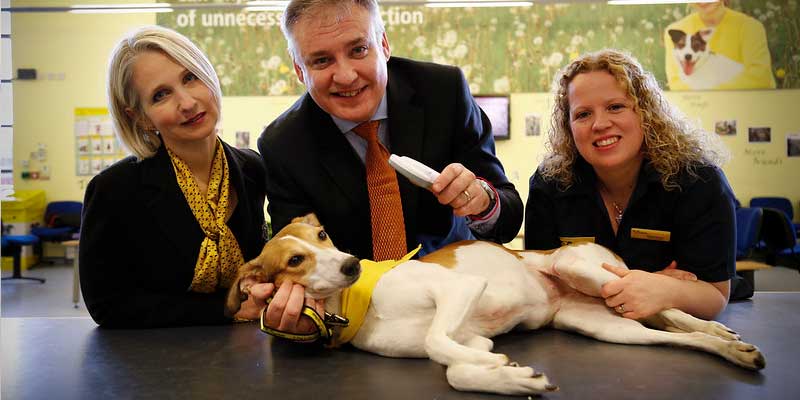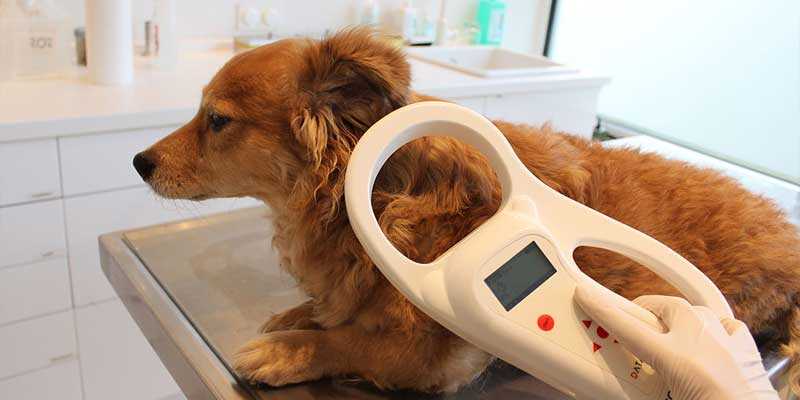
Despite our efforts, accidents happen, and we can’t stop them, but we can plan for them. According to studies, 1 in three pets become lost at some point. That’s a lot of pets that could potentially end up at a shelter or worse.
Best Selling Dog Treats
Last update on 2025-06-09 / Affiliate links / Images from Amazon Product Advertising API
That’s why microchips were invented, to help us find our lost furry friends. How do they work? Microchips are inserted under a dog’s skin and contain a unique identification number. When a dog is lost and found, the finder takes the dog to a shelter or veterinarian, who will scan the chip to find the owner’s contact information.
In this blog, we will discuss dogs’ microchips and how they work. So, let’s get started.
What is a microchip?
It is a small electronic device implanted under a dog’s skin. It contains a unique identification number that a veterinarian or shelter can scan to find the owner’s contact information.
In addition, microchips can also contain other information such as the dog’s medical history, vaccinations, and microchip registration information.
How do dog chips work?
Dog chips contain radio frequency identification (RFID) technology. This technology generates a unique identification number every time the chip is read.
The unique identification number on the microchip is then linked to the owner’s contact information in a database. When the animal is lost and found, the finder takes the animal to a shelter or veterinarian, who will scan the chip to find the owner’s contact information.
Hence, microchips make it easier for owners to locate their lost pets than other tracking methods such as collars or tags.
How and where are microchips placed?
Microchips are typically implanted in a dog’s shoulder or back. This body area is relatively safe from trauma and has fats and muscle tissue that provide good electrical conductivity.
Also, it is easy to reach these areas when a veterinarian performs the procedure.
Microchips are either placed using a needle or an injection gun when your dog is sedated. They have a rubber-like coating that makes it easier to insert and remove them without causing much pain if they are accidentally removed.
How to check if a pup has a microchip?
The best way to find out if your dog has a microchip is to take them to a vet or shelter and have them scanned. If your dog is lost, these are the places you will likely take them to try and find their owner.
In addition, some pet stores also offer microchip scanning services for a fee. However, not all shelters and veterinarians can scan for every type of microchip. So, it is important to contact your local shelter or veterinarian to see if they can scan your pet’s chip before you go there in case your pet is lost.
Benefits of Microchipping Dog

There are several perks of microchipping your pup. Some of these benefits include:
- Easier identification of lost pets
- Reduced chances of being turned over to a shelter
- Fast and easy recovery if your pet is lost or stolen
- It can be used as a permanent form of identification
- It prevents you from having to replace your dog’s collar and tags if they get lost
- Can provide information about your pet’s health history and medications
As you can see, there are many benefits to microchipping your dog. So, if you haven’t already done so, consider having your pet microchipped. It could be the difference between finding your lost pet and never seeing them again.
FAQs
The life of a microchip depends on how the owner receives it. If the chip was implanted into the dog by a veterinarian, its life span is limited only by how long it takes for those operations to heal. However, if it is embedded through chain insertion, this operation is irreversible and permanent, so you can expect the chip to last five years.
There is no law mandating that all dogs must be microchipped, but it is highly recommended. Microchipping is a great way to make sure that your furry friend will be returned to you if they are ever stolen or lost.
Yes, a microchip can be removed from a dog. However, it is a surgical procedure that a veterinarian should only perform.
The cost of microchipping your dog depends on the type of chip you choose and where you have it done. Generally, chips that veterinarians implant cost between $25 and $45. Chips inserted through chain stores or other pet retailers generally cost between $20 and $50.
No, microchipping does not hurt your dog. The chips are coated in a rubber-like material that makes them easy to insert and remove. In addition, they are very small and only weigh a few grams. So, your dog will barely notice that they have been microchipped.
No. However, as with any medical procedure, there are some risks involved. These include bleeding or bruising from the injection and swelling from the catheter. In addition, a dog can develop an allergic reaction to being microchipped which will cause a rash or itching.
While there is no safety issue associated with having your dog receive dental work while they are chipped, it is important to make sure that you don’t accidentally brush your pet’s teeth during this time, as this could cause damage to the chip.
No, dog chips can last up to 25 years. Although it is important to have your dog’s chip updated yearly.
The Bottom Line
Microchipping a dog has proven beneficial for owners as it reduces the chances of purchasing a new collar and tags if the pet is lost. The procedure is rarely painful and doesn’t cause any side effects. In addition, microchipping allows you to find your pet even if they are stolen or lost.
So, if you haven’t done so already, consider microchipping your furry friend. You’ll be glad you did if they are ever lost or stolen.








No info about if the chip tells when placed.